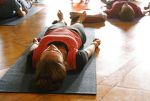Yogic Relaxation Techniques – Yoga Nidra

There are many deep relaxation techniques on the ‘market’ today. This one was taught to me as a part of my Integral Yoga teacher’s training. It is based on the yogic practice of pratyahara (sense withdrawal), which is the fifth limb of Raja yoga and pratyahara. During the Yoga Nidra you will relax the physical body, bringing it and your various levels of energy into balance and being drawn deeper inward away from the distracting body and senses. You are not sleeping, although many students do fall asleep at first. The idea is to be conscious all the way through the various stages. If you keep falling asleep you can try keeping your first slightly tensed or just touch the thumb and first finger. Some people keep an elbow bent or the eyes open or slightly open. If you start to drop off, either the falling of the arm or the movement of the eyes will wake you up. You can always practice Yoga Nidra sitting in a chair. If you do fall asleep, enjoy the rest and try to practice your Yoga Nidra at a time when you are not sleepy. To maximize the benefits of healing and relaxing you need to keep conscious throughout. You can however, use it as a technique to drop off into a deep peaceful sleep if you go through the practice in bed at night.
The Process:
In the first stage of Yoga Nidra you go through the body and tense the different muscle groups. When you tense the body and then let go, it releases far more tension than if you just lie there and try to relax. Lift a limb about 12cm (1in) off the floor, hold it up and squeeze it tight. At the same time, breathe in and hold the breath, forcing the prana through the body. Then let the limb flop down and the breath rush out. The limb gently hits the floor, releasing subtle tension lurking in the muscles. The release of the breath also helps to flush away deep rooted tension. The same principle applies in car maintenance when new grease is used to flush out dirty, old grease.
This process works on the anna maya kosha. You free the body from the build up of tension and, in the process, become more familiar with where you hold tension. With practice you will be able to relax these areas during the day simply by telling them to “let go”. You will learn what it feels like to be really relaxed, enabling you to detect tension and prevent it from building up. If you are on your feet all day or do a lot of walking, you may feel tension in the legs or lower back. Sitting at your desk all day can cause a lot of tension in the lower back. You may have a lot of tension in the hands either from typing or from clenching your fists in stress and anxiety. This tension works its way up the arms to the shoulders. Sitting at the computer can also cause tension in the shoulders and neck, as can carrying heavy shopping bags and children. Worry and stress can manifest themselves in clenched teeth, which cause tension in the jaw, or frowning. Tiredness, depression and all other feelings are expressed in the face. This first stage of Yoga Ida enables you to free yourself from this tension, allowing the energy in the physical body to flow freely. As the physical body relaxes and you finish with movement you experience the sensation of heaviness. Begin with the least vital parts of the body, releasing physical tension and tense energy. Then start to draw energy and awareness in and up towards the head. After tensing and relaxing the physical body and releasing the flow of energy, go through the body mentally to release any subtle tension caused by emotional upset and wounds.
In the next stage you observe the breath, working with prana maya kosha, and then the mind, mano and vijnana maya koshas. You begin to experience a deep sense of peace and stress. With practice you will be able to witness the breath, moving deeper within, away from the body and senses. Then you will be able to keep the awareness on the thoughts, without being wrapped up and involved in the passing drama. You will begin to experience lightness and a further distancing from the body, thoughts and feelings. When the body and mind become calm and relaxed, prana is not needed for their movement, now you can begin to recharge your store of this vital life force.
The final stage is to feel the peace within. There is nothing to do but rest in the peace and enjoy it. In this place of stillness you will know that you are not the body or mind. After resting in this place of peace and contentment for about five minutes, slowly bring the awareness back to the breath and the body, revitalizing the system with prana. Then slowly movement is brought back to the body. It is important to come out of the deep relaxation slowly, so all the bodies, or subtle levels of energy, are balanced and the effects of the relaxation are assimilated. You do not want to come out suddenly, disturbing the peaceful feeling. After Yoga Nidra, you will feel calm and contented; you will have freed yourself from physical tension, emotional upset, worry and anxiety.